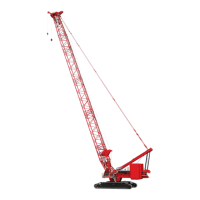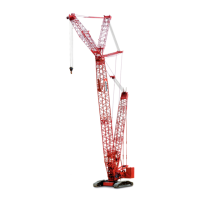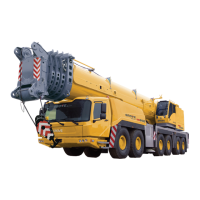Manitowoc Published 04-06-18, Control # 231-14 4-99
MLC650 VPC-MAX™ OPERATOR MANUAL SET-UP AND INSTALLATION
DISASSEMBLING THE VPC-MAX
Lowering the Boom
See Figure 4-82 for the following procedure.
1. Refer to the capacity chart in use for boom lowering
limitations.
2. Travel the ends of the crawlers onto blocking (1) if
required per the Capacity Chart. See Crawler Blocking
in the Capacity Chart Information Manual.
3. Swing the boom to either side of center and lower the
load blocks and/or the hook-and-weight balls to the
ground. Take every precaution to prevent damage to the
load lines.
4. Swing the boom to the required lowering position:
• Over the end of the blocked crawlers
• Over the end or side of the crawlers
5. Slowly lower the boom while performing the following
steps:
a. If equipped with a luffing jib, refer to the Luffing Jib
Operator Manual for lowering instructions.
b. If equipped with a fixed jib, disengage the jib stops
before the jib point contacts the ground.
c. If equipped with an upper boom point, remove the
bottom connecting pins (4, Figure 4-67 on page 4-
78) when the upper boom point just contacts the
ground.
6. Pay out the load lines as the boom lowers.
7. Position blocking (2) that is at least 610 mm (24 in) high
under the bottom connectors between the boom top the
adjacent boom section.
To prevent damage to the boom sections caused by
excessive sag, space additional blocking under the
boom sections at the intervals specified under
“Intermediate Blocking” requirement in the Boom
Rigging Drawing at the end of this section.
8. Stop lowering the boom when the boom straps just start
to lower.
Detaching the Counterweight Straps
See Figure 4-82 for the following procedure.
1. Once the boom is on blocking, enter the fixed mast
configuration and select the proper fixed mast capacity
chart in RCL/RCI display.
2. Check the following:
• The counterweight tray is fully retracted to the
minimum working position of 4 m as indicated in the
VPC-MAX calibration screen (View C, Figure 4-38
on page 4-40). Drive the tray in with the remote
control if necessary.
• The VPC-MAX beam is resting on the hooks (View
B, Figure 4-32 on page 4-33
). Slacken the boom
rigging if necessary.
3. Using the Drum 4 and 5 control handles, slowly haul in
the mast hoist wire rope and pay out boom hoist wire
rope so the counterweight straps are slack.
This step will pull the fixed mast back to approximately
113°, at which point the counterweight links (3) should
be reseting against the stop pins (4).
The
fixed mast angle can be monitored in the fixed mast
working screen in the RCL/RCI display.
4. Disconnect the counterweight straps from the counter-
weight links on one side of the mast at a time:
a. Attach a hand-held tagline approximately 9 m (30 ft)
long to each counterweight strap (5).
The taglines will be used to guide the straps
rearward by assembly personnel when the pins are
removed in step b
.
b. Remove the pin (6) connecting the counterweight
links (3) to the counterweight strap (5).
Repeat step 3
as necessary to loosen the pins.
c. Using the tagline, payout the counterweight strap
until it is hanging vertical.
d. Rotate the counterweight links (3) forward onto the
beam for storage.
e. Reinstall the pin (6) in the counterweight links (3)
and the storage lugs (7, if equipped).
f. Repeat the steps for the other side of the fixed mast.
g. Leave the taglines attached to the counterweight
straps.
WARNING
Falling Boom/Tipping Hazard!
Before lowering the boom:
• Determine the proper counterweight position from the
capacity chart that will allow lowering the boom
length in use.
• Select the required counterweight position in the
RCL/RCI Display when the boom is within the
operating range of the capacity chart.
• Block under the crawlers if required.

